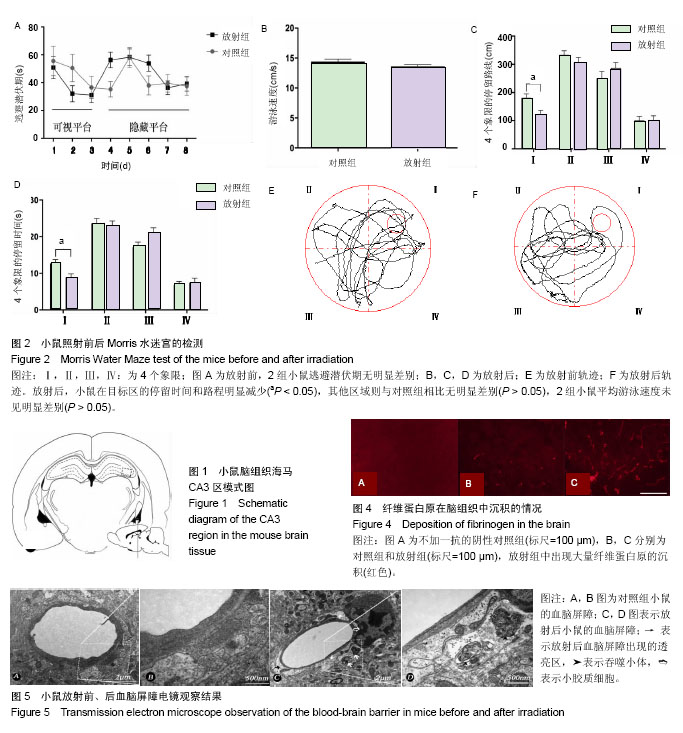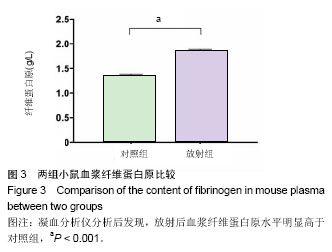| [1] 段纪俊,严亚琼,杨念念,等. 中国恶性肿瘤发病与死亡的国际比较分析[J]. 中国医学前沿杂志:电子版, 2016, 8(7):17-23.[2] Peng Y, Lu K, Li Z, et al. Blockade of Kv1.3 channels ameliorates radiation-induced brain injury. Neuro Oncol. 2014; 16(4):528-539.[3] 陈泊霖,孙熠,梁宾,等.大鼠放射性脑损伤所致血脑屏障通透性改变与EBA及VEGF表达的相关性研究[J].天津医药, 2016,44(6): 691-694.[4] 严沁,陈晓品.颅脑放疗引起认知功能障碍的研究现状[J].中华肿瘤防治杂志,2014, 21(23):1925-1928.[5] 刘雅洁,蔡伟明,徐国镇.鼻咽癌放疗后放射性脑损伤分析[J]. 中华放射医学与防护杂志,2001,21(5):359-360.[6] 史秀云,柳云恩,张玉彪,等.干细胞治疗放射性脑损伤的研究进展[J].创伤与急危重病医学, 2017,5(5):302-304.[7] 李俊晨,李国华,田野,等.放射性脑损伤的MRI研究进展[J].中华放射肿瘤学杂志, 2017, 26(1):98-102.[8] 黄其龙,林斌.纤维蛋白原对神经系统作用研究进展[J].中华神经外科疾病研究杂志,2012,11(1):88-90.[9] Hultman K, Cortes-Canteli M, Bounoutas A,et al.Plasmin deficiency leads to fibrin accumulation and a compromised inflammatory response in the mouse brain. J Thromb Haemost. 2014;12(5):701–712.[10] 张格妙,方琪玮.β-纤维蛋白原-455G/A基因多态性及血浆纤维蛋白原含量与过敏性紫癜肾炎的相关性分析[J].中国药物与临床, 2015, (1):46-48.[11] Petersen MA,Ryu JK,Chang KJ,et al.fibrinogen Activates BMP Signaling in Oligodendrocyte Progenitor Cells and Inhibits Remyelination after Vascular Damage.Neuron. Neuron.2017; 96(5):1003-1012.e7. [12] 李鑫,廉春蓉,阮林,等.全脑照射后对小鼠血脑屏障通透性和室管膜下区细胞增殖的影响[J].神经解剖学杂志,2012,28(3):278-282.[13] Liu Y,Xiao S,Liu J,et al.An experimental study of acute radiation-induced cognitive dysfunction in a young rat model. AJNR Am J Neuroradiol.2010;31(2):383-387.[14] 韦力,廉春蓉,阮林,等.60Co-γ射线照射对小鼠SVZ神经干细胞增殖的影响[J].神经解剖学杂志,2011,27(1):55-58.[15] Royea J,Zhang L,Tong XK,et al. Angiotensin IV receptors mediate the cognitive and cerebrovascular benefits of losartan in a mouse model of Alzheimer's disease.J Neurosci.2017;37(22):5562-5573.[16] Li X,Fan G,Zhang Q,et al.Electroacupuncture decreases cognitive impairment and promotes neurogenesis in the APP/PS1 transgenic mice. BMC Complement Altern Med. 2014;14:37.[17] Rouvinski A,Karniely S,Kounin M,et al.Live imaging of prions reveals nascent PrPSc in cell-surface, raft-associated amyloid strings and webs.J Cell Biol.2014;204(3):423-441.[18] 阮林,韦力,廉春蓉,等.全脑照射后血脑屏障改变对放射性脑损伤的影响[J].中国神经精神疾病杂志,2011,37(10):591-595.[19] 田书娟,吴卫平.纤维蛋白沉积与多发性硬化和周围神经损伤关系研究现状[J].脑与神经疾病杂志,2008,16(2):149-151.[20] 薛双亮,肖乐,龚昆梅,等.纤维蛋白原与恶性肿瘤关系的研究进展[J].中华普通外科杂志,2012,27(10):858-860.[21] Lazzarino A I,Hamer M,Gaze D,et al.The association between fibrinogen reactivity to mental stress and high-sensitivity cardiac troponin T in healthy adults. Psychoneuroendocrinology. 2015; 59:37-48.[22] 周斌,张俊平,胡振林,等. 一种高血浆纤维蛋白原动物模型的建立[J]. 第二军医大学学报,1999,20(1):57-61.[23] Giovine GD,Verdoia M,Barbieri L,et al.Impact of diabetes on fibrinogen levels and its relationship with platelet reactivity and coronary artery disease: A single-centre study. Diabetes Res Clin Pract. 2015;109(3):541-550.[24] Lovely R,Hossain J,Ramsey JP,et al.Obesity-related increased γ' fibrinogen concentration in children and its reduction by a physical activity-based lifestyle intervention: a randomized controlled study. J Pediatr. 2013 ;163(2):333-338.[25] 刘燚隆,王香芝,侯芳素,等.血浆纤维蛋白原水平与急性脑梗死的相关性研究[J].临床合理用药,2014,7(12A):82-83.[26] Tuut M,Hense HW.Smoking, other risk factors and fibrinogen levels. evidence of effect modification. Ann Epidemiol. 2001; 11(4):232-238.[27] 梁萌,左朦,赵娜娜,等.青年缺血性卒中患者早期不良结局的相关因素分析[J].中国脑血管病杂志,2017,14(8):393-398.[28] Rosenson RS. Effect of Fenofibrate on Adiponectin and Inflammatory Biomarkers in Metabolic Syndrome Patients. Obesity.2009;17(3):504.[29] 甘露,魏麓云.纤维蛋白原与多发性硬化的研究进展[J].中国现代医药杂志,2008,10(8):130-132[30] Eaton JW. Molecular Determinants of Acute Inflammatory Responses to Biomaterials.J Clin Invest. 1996;97(5):1329-1334.[31] 刘瑛,郭力.纤维蛋白原水平与颈动脉粥样硬化[J].医学综述, 2006, 12(7):441-443.[32] Aleman MM, Walton BL,Byrnes JR,et al. Fibrinogen and red blood cells in venous thrombosis. Thromb Res.2014;133(5):S38-S40.[33] Liu Y, Xiao S, Liu J, et al. An experimental study of acute radiation-induced cognitive dysfunction in a young rat model. AJNR Am J Neuroradiol.2010;31(2):383-387.[34] Xin N,Li Y J,Li Y, et al. Dragon's blood extract has antithrombotic properties, affecting platelet aggregation functions and anticoagulation activities.J Ethnopharmacol. 2011;135(2): 510-514.[35] 邢东,吴志新,董辉,等.电针预处理对MCAO大鼠模型血脑屏障和MMP-9的影响[J].神经解剖学杂志,2017,33(4):383-389.[36] Adhami F, Liao G, Morozov YM, et al. Cerebral Ischemia-Hypoxia Induces Intravascular Coagulation and Autophagy.Am J Pathol. 2006;169(2):566-583.[37] Pérès E, Boumezbeur F, Etienne O, et al. ESMRMB 2015 Congress - abstract 328 - Diffusion MRI is a sensitive biomarker of radiation injury in the mouse brain[C]// ESMRMB 2015 Congress. 2015.[38] Liscák R, Vladyka V, Jr N J, et al. Leksell gamma knife lesioning of the rat hippocampus: the relationship between radiation dose and functional and structural damage. J Neurosurg. 2002;97 (5 Suppl):666-673.[39] Noguchi M,Sato T,Nagai K,et al.Roles of serum fibrinogen α chain-derived peptides in Alzheimer's disease. Int J Geriatr Psychiatry. 2013;29(8):808–818.[40] Cunningham C.Microglia and neurodegeneration: the role of systemic inflammation.Glia.2013; 61(1):71-90.[41] Eyo UB,Miner SA,Weiner JA,et al.Developmental changes in microglial mobilization are independent of apoptosis in the neonatal mouse hippocampus. Brain Behav Immun. 2015;55: 49-59.[42] Jin SJ, Liu Y, Deng SH, et al.Neuroprotective effects of activated protein C on intrauterine inflammation-induced neonatal white matter injury are associated with the downregulation of fibrinogen-like protein 2/fib roleukin prothrombinase and the inhibition of pro-inflammatory cytokin. Int J Mol Med.2015;35(5): 1199-212.[43] Bai Y,Xu G,Xu M,et al.Inhibition of Src phosphorylation reduces damage to the blood-brain barrier following transient focal cerebral ischemia in rats.Int J Mol Med.2014;34(6):1473-1482.[44] Schachtrup C, Lu P, Jones LL, et al.fibrinogen Inhibits Neurite Outgrowth via β3 Integrin-Mediated Phosphorylation of the EGF Receptor.Proc Natl Acad Sci U S A.2007;104(28):11814-11819.[45] 许冰.从炎症反应和氧化应激探究麻醉剂影响老龄大鼠认知功能的分子机制[D].山东大学,2016.[46] 武海霞,吴志刚,刘红彬,等. Morris水迷宫实验在空间学习记忆研究中的应用[J]. 神经药理学报, 2014,4(5):30-35.[47] 张媛,孙锐,朱雅群,等. 慢性强迫游泳运动对大鼠放射性认知功能障碍的影响及其机制[J]. 中华放射医学与防护杂志, 2014,34(9): 658-662. |
.jpg)
.jpg)


.jpg)